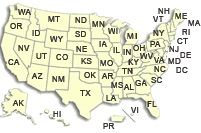
RedN NAWQA
USGS IN YOUR STATE
USGS Water Science Centers are located in each state.

|
Red River of the North Basin
National Water-Quality Assessment Program
Brigham, M.E. and Lorenz, D.L., 1997, Water quality in the Red River of
the
North during the spring flood of 1997. Proceedings of the North Dakota
Academy of Science, 89th Annual meeting, Sept. 15-16, 1997, Grand Forks
N. Dak., v. 51, supplement 1, p. 30. [abstract only]
Abstract
Sources of contamination to the Red River of the North and its tributaries
during the spring flood of 1997 included: dead animals, feedlots, municipal
sewage treatment systems, petroleum from flooded fuel-oil tanks, cars, and
possibly industrial and agricultural chemicals. Several agencies (North
Dakota State Health Department, Minnesota Pollution Control Agency, and
U.S. Geological Survey [USGS]) sampled the Red River at several locations
weekly for nutrients, pesticides, volatile organic compounds (VOCs), and fecal
bacteria to document water-quality conditions. Environment Canada sampled the
Red River of the North at Emerson, Manitoba.
In the Red River Basin, nutrient levels typically reach their annual maxima
during spring-snowmelt runoff (phosphorus can also be high during summer
runoff events). Maximum dissolved nitrate nitrogen concentrations measured
during the flood (1.5 mg/L upstream of Fargo, 1.1 mg/L at Grand Forks, and 1.0
mg/L at Pembina) were lower than concentrations measured from 1993-95 during
spring-snowmelt runoff (3.4 mg/L upstream of Fargo, 3.7 mg/L at Grand Forks,
and 4.6 mg/L at Pembina). Dissolved ammonia and organic nitrogen and total
phosphorus concentrations were similar to those measured from 1993-95.
Several pesticides were detected, but at low concentrations characteristic of
spring runoff periods. Atrazine, de-ethylatrazine, and metolachlor were
detected in all samples from the Red River of the North. The maximum
concentration of atrazine (0.145 µg/L upstream of Fargo) was much
greater than the maximum measured during spring runoff from 1993-95 (0.033
mg/L upstream of Fargo).
Petroleum (gasoline or fuel oil) was observed on the river surface and VOCs
(alkylbenzenes and naphthalene) were detected in samples. In some samples,
traces of chlorinated solvents were detected (all concentrations were less
than 1 µg/L). Other VOCs that were occasionally detected are methyl
ethyl ketone (0.4-3.7 µg/L), and acetone (1-2 µg/L).
Fecal coliform and fecal streptococci are indicators of contamination from
animal waste or human waste. Fecal coliform counts were 81 colonies/100mL
upstream of Fargo, 149 at Grand Forks, and 26 at Pembina, North Dakota. Fecal
streptococci counts were fairly high during the flood (2,100 colonies/100mL
upstream of Fargo, 10,900 colonies/100mL at Grand Forks, and 9,380
colonies/100mL at Pembina). Fecal streptococci levels are higher than recent
years (1982-94) (1,500 colonies/100mL upstream of Fargo and 720 colonies/100mL
at Pembina). The ratios of fecal coliform to fecal streptococci colonies are
all much less than 0.6, which indicates that contamination primarily is from
agricultural sources.
|